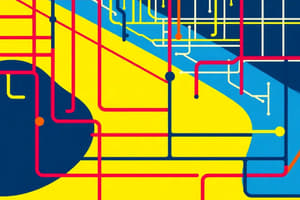Podcast
Questions and Answers
What method can be used by two computers to ensure that packets are not dropped because too much data is being sent too quickly?
What method can be used by two computers to ensure that packets are not dropped because too much data is being sent too quickly?
flow control
What type of communication will send a message to all devices on a local area network?
What type of communication will send a message to all devices on a local area network?
broadcast
What process is used to place one message inside another message for transfer from the source to the destination?
What process is used to place one message inside another message for transfer from the source to the destination?
encapsulation
From the perspective of the client, what is the correct order of the protocol stack that is used to prepare the request for transmission?
From the perspective of the client, what is the correct order of the protocol stack that is used to prepare the request for transmission?
Which statement is correct about network protocols?
Which statement is correct about network protocols?
The TCP/IP transport and OSI Layer 4 provide different services and functions.
The TCP/IP transport and OSI Layer 4 provide different services and functions.
What is an advantage of using standards to develop and implement protocols?
What is an advantage of using standards to develop and implement protocols?
What three application layer protocols are part of the TCP/IP protocol suite?
What three application layer protocols are part of the TCP/IP protocol suite?
What are proprietary protocols?
What are proprietary protocols?
What is an advantage of network devices using open standard protocols?
What is an advantage of network devices using open standard protocols?
If Host1 were to transfer a file to the server, what layers of the TCP/IP model would be used?
If Host1 were to transfer a file to the server, what layers of the TCP/IP model would be used?
Which three layers of the OSI model are comparable in function to the application layer of the TCP/IP model?
Which three layers of the OSI model are comparable in function to the application layer of the TCP/IP model?
At which layer of the OSI model would a logical address be encapsulated?
At which layer of the OSI model would a logical address be encapsulated?
Which PDU format is used when bits are received from the network medium by the NIC of a host?
Which PDU format is used when bits are received from the network medium by the NIC of a host?
Which PDU is processed when a host computer is de-encapsulating a message at the transport layer of the TCP/IP model?
Which PDU is processed when a host computer is de-encapsulating a message at the transport layer of the TCP/IP model?
Host A is attempting to contact Server B; what two statements correctly describe the addressing that Host A will generate in the process?
Host A is attempting to contact Server B; what two statements correctly describe the addressing that Host A will generate in the process?
Which address does a NIC use when deciding whether to accept a frame?
Which address does a NIC use when deciding whether to accept a frame?
What will happen if the default gateway address is incorrectly configured on a host?
What will happen if the default gateway address is incorrectly configured on a host?
Which characteristics describe the default gateway of a host computer?
Which characteristics describe the default gateway of a host computer?
Match the organizations with their descriptions:
Match the organizations with their descriptions:
Match the protocol function to the corresponding application process while taking into consideration that a network client is visiting a website:
Match the protocol function to the corresponding application process while taking into consideration that a network client is visiting a website:
What is message encoding?
What is message encoding?
What is message sizing?
What is message sizing?
What is message encapsulation?
What is message encapsulation?
Flashcards
Flow Control
Flow Control
Prevents packet loss by managing data transmission speed between devices.
Broadcast Communication
Broadcast Communication
Sends messages to every device on a local network.
Encapsulation Process
Encapsulation Process
Wrapping a message inside another for transmission.
Web Client Request Order
Web Client Request Order
Signup and view all the flashcards
Network Protocol Definition
Network Protocol Definition
Signup and view all the flashcards
TCP/IP vs. OSI Model
TCP/IP vs. OSI Model
Signup and view all the flashcards
Inter-operability through Standards
Inter-operability through Standards
Signup and view all the flashcards
Open Standard Protocols Benefits
Open Standard Protocols Benefits
Signup and view all the flashcards
TCP/IP File Transfer Layers
TCP/IP File Transfer Layers
Signup and view all the flashcards
Comparable OSI Layers
Comparable OSI Layers
Signup and view all the flashcards
Logical Address Encapsulation
Logical Address Encapsulation
Signup and view all the flashcards
PDU Formats
PDU Formats
Signup and view all the flashcards
Address Generation for Host Communication
Address Generation for Host Communication
Signup and view all the flashcards
NIC Frame Acceptance
NIC Frame Acceptance
Signup and view all the flashcards
Default Gateway Configuration
Default Gateway Configuration
Signup and view all the flashcards
Default Gateway Characteristics
Default Gateway Characteristics
Signup and view all the flashcards
ISOC
ISOC
Signup and view all the flashcards
ISO
ISO
Signup and view all the flashcards
IANA
IANA
Signup and view all the flashcards
Application Protocol
Application Protocol
Signup and view all the flashcards
Internet Protocol
Internet Protocol
Signup and view all the flashcards
Network Access Protocol
Network Access Protocol
Signup and view all the flashcards
Transport Protocol
Transport Protocol
Signup and view all the flashcards
Message Sizing
Message Sizing
Signup and view all the flashcards
Study Notes
Network Protocols and Communications
- Flow Control: A method used to prevent packet loss due to excessive data transmission speed between two computers.
- Broadcast Communication: Sends messages to all devices on a local area network, ensuring widespread delivery within the network.
- Encapsulation Process: Involves placing one message within another for transfer, ensuring that the original message is properly packaged for delivery.
Protocol Stacks and Models
- Web Client Request Order: For a webpage request, the transmission protocol stack follows the order: HTTP, TCP, IP, Ethernet.
- Network Protocol Definition: Protocols establish rules for how messages are exchanged from source to destination.
- TCP/IP vs. OSI Model: Both models’ layers 4 (TCP/IP transport) and OSI Layer 4 offer comparable services and functions.
Advantages of Protocol Standards
- Inter-operability through Standards: Standardized protocols allow products from various manufacturers to work together seamlessly.
- Open Standard Protocols Benefits: Facilitate successful data exchange even between clients and servers running different operating systems.
TCP/IP and OSI Layers
- TCP/IP File Transfer Layers: When transferring a file, the layers involved in the TCP/IP model are application, transport, Internet, and network access.
- Comparable OSI Layers: The application layer in TCP/IP corresponds to the application, presentation, and session layers of the OSI model.
Addressing and Routing
- Logical Address Encapsulation: Occurs at the network layer of the OSI model, where addresses are prepared for transmission.
- PDU Formats: A "frame" is used when bits are received by a Network Interface Card (NIC), while a "segment" is processed at the transport layer when de-encapsulating messages.
- Address Generation for Host Communication: Host A generates a frame with Router A’s MAC address and a packet using Server B’s IP address during communication.
Host Configuration and Networking
- NIC Frame Acceptance: A Network Interface Card (NIC) checks the destination MAC address to decide if it should accept a frame.
- Default Gateway Configuration: If the default gateway is incorrectly set, the host cannot communicate with devices outside its own network.
- Default Gateway Characteristics: It is the logical address of the router interface residing on the same network as the host.
Organizations and Protocol Functions
- ISOC: Promotes open Internet development, evolution, and usage globally.
- ISO: The largest international standards developer, known for the OSI reference model.
- IANA: Manages IP address allocation, domain names, and protocol identifiers.
Protocol Functions in Web Client Interaction
- Application Protocol: Governs the interaction between web servers and clients.
- Internet Protocol: Encapsulates transport protocol segments into packets.
- Network Access Protocol: Prepares packets for transmission over network media.
- Transport Protocol: Manages conversations between web servers and clients.
Message Processing
- Message Encoding: Converts information from one format to another for seamless transmission.
- Message Sizing: Breaks long messages into smaller segments before network transmission.
- Message Encapsulation: Involves embedding one message format within another for efficient communication.
Studying That Suits You
Use AI to generate personalized quizzes and flashcards to suit your learning preferences.




